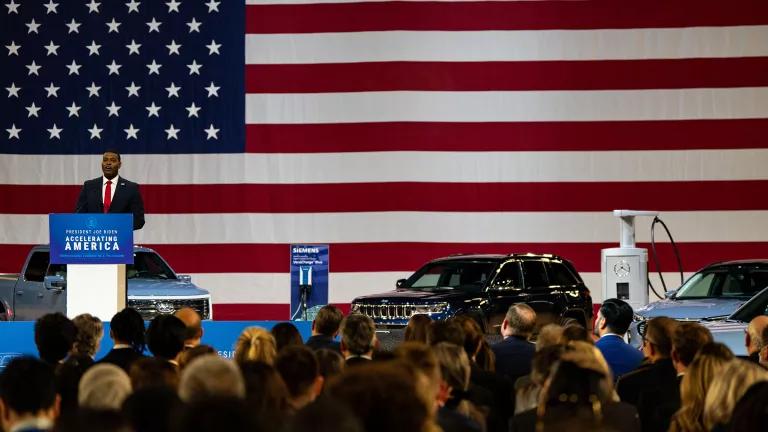Reforming Rates for Electric Trucks, Buses & Fast Chargers
A new report explains how utilities can offer rates better suited for commercial EV charging.

A New Flyer XE40 electric bus at a charging station in New York City on May 25, 2021.
Marc A. Hermann/MTA
Charging an electric truck or bus at a fleet depot—or an electric car at an apartment, workplace, or a public fast-charging station—should be far cheaper than filling up on gasoline or diesel. Unfortunately, that’s often not the case at sites that receive electricity under utility rates designed for commercial buildings and industrial operations that don’t reflect the flexible nature of electric vehicle (EV) charging. Fortunately, a new report explains how utilities can remedy that mismatch by offering rates better-suited for commercial EV charging.
While a number of utilities have begun to acknowledge this problem by developing new rates specifically for commercial EV charging, the 2022 Infrastructure Investment and Jobs Act (IIJA) now requires all 50 state Public Utilities Commissions and nonregulated utilities to begin considering new rates to support transportation electrification.
To help regulators and utilities complying with these requirements, the new report explores several examples of recently adopted commercial EV rates that serve as helpful models for designing long-term solutions for improving the economics of commercial EV charging, without subsidizing EV charging or shifting costs to other customers.
In short, utilities should design new commercial EV rates that provide significant fuel cost savings to drivers and fleet operators who charge in a manner that supports the electric grid, reflect the underlying marginal costs of serving commercial EV load, and avoid traditional demand charges which often collect much more than the actual costs commercial EV charging imposes on the grid.
Moving from Band-Aids to Long-Term Solutions
Electric buses, trucks, and public fast charging stations aren’t like buildings—EVs charge for only a few hours a day and can shift their charging demand to when most people are sleeping and there is plenty of spare capacity on the electric grid—but until now they’ve generally been forced onto rate plans designed for large buildings and industrial operations that use electricity more constantly. Most traditional commercial and industrial (C&I) rates include demand charges based on the customers’ highest point of demand for electricity at any time in a given month. Because EVs consume a lot of electricity while plugged in, these demand charges mean big bills which can erase fuel cost savings relative to gasoline or diesel, even if they’re charging when the grid is underutilized and electricity is cheap.
While some utilities have proposed short-term “fixes” that rely upon subsidies or discounts, they would do better to borrow from these best practices and implement sustainable solutions akin to those developed by Pacific Gas & Electric (PG&E), San Diego Gas & Electric (SDG&E), and Southern California Edison (SCE), and Alabama Power.
PG&E's Commercial & Industrial EV Rates
PG&E’s new rate permanently ditches demand charges, replacing them with smaller and more predictable subscription fees. Those subscription fees are just like what you see on your cell phone bill, with sites paying a fixed monthly rate based on their total charging capacity. But unlike the typical cell phone bill, that fixed subscription fee will only account for a relatively small portion of the total bill. The majority of the bill will be determined by time-of-use charges that reflect how much electricity is used and when it is used, encouraging customers to charge when the grid is underutilized and when renewable energy is abundant.
On PG&E’s previously existing commercial and industrial rates, the cost of charging is often equal to or more expensive than filling up with gasoline or diesel (see orange diamonds in figure below). However, under PG&E’s new commercial EV rates, customers save 25 percent to 60 percent or more on their monthly bills, which translates into a cost per gallon equivalent less than half the price of gasoline or diesel fuel. (see green bars in figure below).

PG&E
SDG&E's Commercial & Industrial EV Rates
Borrowing from the structure of PG&E’s rate, SDG&E proposed its own new commercial and industrial rates ditching demand charges for more predictable monthly subscriptions. SDG&E estimates the new rates will save drivers and fleet operators up to twenty to forty-five percent on their monthly bills as designed and further modified by a joint settlement in that case.
Notably, both PG&E and SDG&E’s rates are based on the utilities’ underlying marginal costs. By recognizing that commercial EVs are new load on the system and charging these customers only the additional costs they impose on the grid, rather than saddling them with historical costs imposed by other customers, these rates will help improve the economics of commercial EV adoption during the critical developing years of the market—without subsidizing EV charging or shifting costs to other customers. Further, because widespread EV charging can put downward pressure on rates for all electric customers by spreading the costs of maintaining the grid over more sales of electricity, these new rates benefit everyone in the long run by helping to expand the commercial EV market and bring this new load onto the system.
SCE's Commercial & Industrial EV Rates
SCE’s approach to the demand charge problem focuses on ditching demand charges for the next five years and recovering costs purely through “time-of-use” rates (based on the total amount of electricity used and when it’s used). After five years, demand charges will be phased back in, with the theory being that demand charges won’t be such a big deal when there are more EVs on the road, increasing charging station utilization and allowing customers to spread the demand charges over more hours of charging.
Alabama Power’s Economic Development Rider
Similar to SDG&E’s rate, Alabama Power offers an Economic Development Rate Rider which customers on their Business EV Rate can enroll in. With the Rider, a customers’ base rate is discounted to 110% of their estimated marginal cost, with a maximum discount on their base rate which declines over a predictable multi-year period. This model could present an alternative to developing separate EV-specific commercial rates, with utilities instead opening up existing technology-agnostic economic development rate riders to commercial EV customers.
Paving the Path for Future EV Rate Design
Done right, new and improved rates that more accurately reflect the cost of commercial EV charging could fundamentally change the economics of a decision to invest in medium- and heavy-duty EVs in utilities’ service territories, enabling widespread transportation electrification that improves the utilization of the electric grid and helps achieve states’ climate, equity, and air quality goals. Utilities across the nation looking to take the first step towards new commercial EV rates can look to these best practices and models as they go about complying the new federal requirements.
An electric transit bus that charges overnight while people are sleeping is not the same thing as a factory that’s running around the clock—it’s time for utility rates to recognize the difference.



